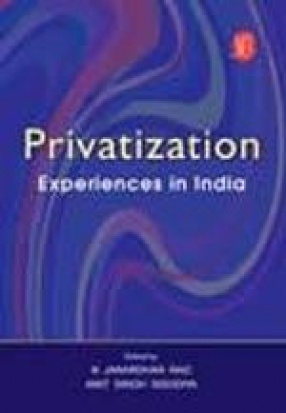
N. Janardhan Rao

Showing all 17 books









Formulating an effective urban planning on account of urbanization is a major issue facing India, today. Rising population coupled with growing migration from rural areas is putting an enormous burden on the country’s cities, already faced with poor and deteriorating infrastructure; according to the latest census data, the urban population at 286 million constitutes about 28% of the country’s total population of 1028 millions. The problem is further worsened ...

In a knowledge-based economy, knowledge alone sustains competitive advantage, whether at an organizational or at a national level. Four structural forces drive economic transformation globally-revolutionary changes in Information and Communication Technology (ICT), rapid scientific and technological advances, increasing global competition, and shifting consumer demand. They also make knowledge a very important driver of competitive advantage The first of this ...

After the Industrial Revolution, which was followed by the technology revolution, the world is now witnessing another revolution driven by knowledge. Earlier, growth was determined mainly by the availability of land, labor, capital and natural resources. However, in the 21st century, knowledge is recognized as one of the crucial factors for economic growth. Organizations need to be adept at absorbing, creating, and applying new knowledge in order to thrive in a ...

After World War II, Japan was the dominant country of Asia. However, since the 1990s, Japan is being pulled into deflationary pressures, stock market and real estate crises. What was left was ailing banks, high interest rates, huge deficit, an ageing population and unemployment. Can Japan return to glory days? .

For centuries, agriculture has shaped the outlook, thought, culture and economic growth of India. Since the green revolution, India has emerged from the shadows of being a net importer of food grains to becoming the largest producer of fruits and the second largest producer of vegetables apart from being the second largest producer of paddy globally.

The world accepts the might of the US economic power. In fact, its policies have shaped world trade agreements and institutions such as the World Bank and the International Monetary Fund (IMF). In the period 1949-1973, the US economic growth was very strong and when Bill Clintons presidential tenure ended, it had a budget surplus of $5.6 trillion.

Over the last 20 years, China's economy has grown to over 8% annually. From being the "workshop of the world" it has become a manufacturing hub of low-cost quality goods and an industrial nation. Despite this, it faces growing corruption, unemployment and a widening gap between the rich and the poor. To know more, read this book.

The word 'Subprime' was voted the word of the year in 2007 by the American Dialect Society. And fittingly so. Subprime crisis remained the most talked about and debated issue among policymakers, central bankers, media and the public, not just in the US but in other continents like Europe and far-off countries such as China and India. The fears of a contagion effect became evident after the British lender, Northern Rock, disclosed in September, 2007, that it ...

Globally, SMEs' role in development and job creation has been well recognized. In India, post-independence, SMEs gained in importance with the advent of planned economy from 1951 till 1991 as the subsequent industrial policy followed by the Government earmarked a special role for the SME segment. Due protection was accorded to the segment till 1991. SMEs always represented the model of socio-economic policies of the Government of India which emphasized judicious ...

The global economy is moving towards the services sector. In India, the sector contributes 52% to the GDP. Hence, managing the sector is an important aspect. Nearly 64% of the world population is greatly dependent on the services sector and this has created an urgency to assess the standards adopted in the existing system. The services sector, therefore, needs special attention to gain essential competitive advantage. Knowledge management in the services sector ...

The PSUs were created to play a pivotal role as envisaged in the economic model adopted by the country in the post-independence era, inspired essentially by the Soviet socialist model. A large number of PSUs were set up across sectors, which have played a significant role in terms of job creation, social welfare, and overall economic growth of the nation; they rose to occupy commanding heights in the economy. Over the years, however, many of the PSUs have failed ...

If a sector that has grown phenomenally in India, but has not got the kind of attention the financial market has got, it is the real estate sector. In 2005 alone, the real estate market in the country touched a total of 23 million sq. ft. of new space, as compared to 18 million sq. ft. in 2004. The housing sector has also been growing at an average of 34% annually and experts estimate that there will be annual shortfall of 20 million housing units through 2011, ...

Amidst galloping oil prices and concern about the potential impact of fossil fuels on the environment, alternative sources of energy are garnering increased attention in the recent past. Moreover, the impact of the growing demand from countries like India and China will be responsible for the future changes in the global oil demand against finite and depleting oil resources. With the global oil production expected to peak around the year 2010-15, it would ...

This book tries to look at the entire sweep of emerging trends, international experiences and challenges faced by the biotechnology industry. Globally, this industry is in a state of transition. Although the biotechnology industry has received acclaim for mapping the human genome and developing cloning technology, it faces many challenges.

We are a knowledge society where being average does not count. The stress is on excellence and success—both of which depend on quality of knowledge. This book stresses on the need for knowledge management (KM) in our education system. KM techniques can be used in higher education to improve and develop processes.

The term, 'Bottom of the Pyramid,' was first coined by management guru, CK Prahalad, who along with Stuart Hall of Cornell University in his 2002 path-breaking article, "The Fortune at the Bottom of the Pyramid," provided the first articulation of how companies can profitably serve a huge untapped market of more than 4 billion people living on less than $2 per day, which according to Prahalad, has remained largely underserved and unserved till today. ...
